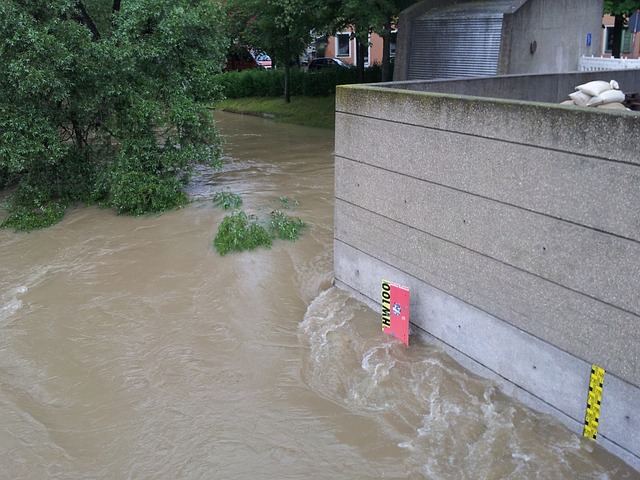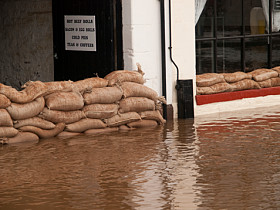 Recent flooding events experienced across the UK, particularly over the last decade have shown the devastating impact that flooding can have on property, businesses and individuals.
Recent flooding events experienced across the UK, particularly over the last decade have shown the devastating impact that flooding can have on property, businesses and individuals.
While it may not always be possible to eliminate the risk of flooding altogether, many practical steps can be taken to reduce the risk of flood damage and assist with recovery times. The aim of this guidance is to provide some simple practical measures that can be taken to mitigate the flood risk and subsequent damage.
Pre-event – what can be done to manage your business flood risk?
Before considering ways to protect your property it is important to assess the likelihood of flooding by considering such factors as:
a) Prior flooding history.
b) Proximity to rivers, streams, and other similar water channels and open bodies of water e.g. lakes,
c) reservoirs etc.
d) Proximity to surface water drainage ditch or stream
e) Is the property located in a low lying area?
f) Is the property situated in a known flood plain?
g) Any basements, cellars or similar used by you which may be affected by surface water flooding/ingress?
If you have answered ‘yes’ to any of these, you should consider what you can do to reduce the risk and take action to prepare in advance, such as:
• Raising the elevations of critical equipment and stock, or relocating particularly vulnerable equipment to other parts of the premises, or to an upper floor. In particular consider computer servers, telecommunication cabinets, business critical machinery (if it is not possible to elevate, can some component parts such as the control panels be rotected/elevated?).
• Stock in the open should be on purpose made, elevated metal racking secured to the ground.
• Fuel storage tanks to be suitably anchored so when under flood conditions will not become damaged and float away causing pollution.
• Where critical plant is located in basements and cannot be relocated then the area should be protected from water ingress.
• Raising electrical and telecommunications points such as sockets, telephone connections etc to a higher point (e.g. consider raising to 1 metre or above expected water levels).
• Consider replacing susceptible linings, furniture, fixtures and fittings with more water resisting alternatives, e.g. stone/plastic floorings, tiled or water resistant wall coverings, water retardant plasters and linings, plastic kitchen cupboards etc.
• Develop and/or extend existing emergency plans to include actions in the event of flooding.
• Make up a flood kit – including critical key business documents, torch, battery, wind-up radio, mobile phone, rubber gloves, wellington boots, waterproof clothing and a first aid kit. Also, have your insurer’s emergency helpline number, details of the policy and other useful numbers such as customers, suppliers, the local council and emergency services.
• Where available subscribe to flood alert warnings such as the Environment Agency Flood Alert Scheme.
• Consider investment in local property flood protection devices e.g. demountable barriers, air brick covers, non return valves for drains and sewerage waste pipes. Ensure staff familiarity with deployment.
• Consider the health and safety of employees and visitors.
• Regularly check the building structure for defects, cracks and gaps through which water could enter the premises and seal them.
• Ensure that routine inspection, maintenance of drainage systems (i.e. guttering, down pipes and drains) is undertaken at least annually. If you become aware that the local street drainage system cannot cope in times of rainfall, report to the controlling authority as it may be that it has become silted up and needs cleaning.
What you can do if the threat of flooding is imminent
• Where possible, turn off gas, electricity and water supplies at the mains (ensure that power to alarm/security systems can be maintained during these times).
• Unplug all electrical items and where possible store them up high or on upper storeys. With heavy electrical items consider the possibility of raising them above anticipated water levels.
• Close off flow valves on gas tanks, oil tanks etc that supply the premises through pipes and fittings.
• Consider the need to move furniture, machinery, and stock to upper storeys.
• Deploy any temporary flood protection measures.
• Vehicles and trailers to be moved to higher and secure ground.
• Be alert to the risk of flooding caused not only by rivers but also surface water building up and overwhelming drains following heavy spells of rainfall leading to localised floods.
• Consider relocating any vulnerable stock which may be in any open yards where possible.
What you can do during a flood
• Cooperate with the emergency services if they tell you to evacuate during flooding.
• Be prepared to act quickly to get yourself and your employees to safety.
• Don’t try and walk or drive through flood waters – 6 inches of fast flowing water can knock you off your feet and 2 feet of water will float your car.
• Be aware that man hole covers may come off and there may be other hazards you can’t see.
• Don’t walk on sea defences, river banks or cross bridges as they may collapse or you could be swept off by a large wave.
• Avoid contact with flood water as it may be contaminated with sewage.
Immediate actions following a flood to your business
• Contact your insurance company and/or insurance broker and advise what has happened. They will then be able to provide best guidance and instigate any specialist services required. Make sure your insurance company knows where to contact you if you have had to move out.
• If you are making an insurance claim, avoid disposing of any items until you are told to do so.
• Don’t use electrical or gas supply in flooded properties until appropriate checks have been undertaken by a qualified person.
• Take photos of the damage to any contents and/or building as this may assist with settlement of your claim.
• Covers on air bricks should be removed once the flood has receded to allow air to circulate and any trapped water to escape.
• Flood protection devices to be cleaned as soon as possible to avoid potential contamination.
Reducing damage and disruption in the future
All properties that have been flooded could benefit from some degree of flood-resilient repair. Some resilience techniques may not cost substantially more than standard repair (like-for-like) and these may be an appropriate way to repair a range of flooded properties.
If your business continues to have a significant risk of flooding, it would be worth repairing your property after a flood with a comprehensive set of flood resilient measures and in such instances some expenditure may be required by you which are beyond the costs covered by your insurance claim.
Repairing a property that has been flooded offers an opportunity to minimise the damage and disruption that could be caused by flooding in the future to your property. There are two main approaches:
• Flood resilience – reduces damage caused when flood water gets inside the property.
• Flood resistance – reduces the amount of water that gets inside the property.
There is a growing range of products and techniques for keeping floodwater out of your property and it is important that only products suitable for the intended end use application are considered. We would recommend those products that have been independently tested under the BSI Kitemark scheme and proved fit for purpose. It is your responsibility to ensure that the products are appropriate for your property and are correctly fitted and maintained.
Information supplied by Aviva. Aviva accepts no responsibility for action taken as a result of information contained in this article.












Leave a Reply